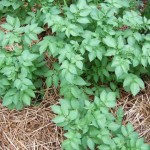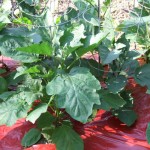A visitor browsing through photos of the garden was curious and inquired into the types of mulch and the various techniques that are employed to mulch my organic raised bed garden.
Here’s her mulch question followed by what may come as a surprising admission regarding the application of mulches in the vegetable garden:
“I love your blog I only wished I had discovered it in January and not April… I would have done things differently. I noticed that you thoroughly mulch your beds and was wondering what you recommend and use for mulch.” – Cameron
Much Ado Over Mulches
 And now I’ll come clean on the subject: I’m not fanatical about mulching the vegetable beds and despite the appearances I really don’t apply a lot of mulch. My veggie patch is never a foot deep in mulches in the manner of those gardening systems that pile heaps of organic matter onto the surface of their growing beds.
And now I’ll come clean on the subject: I’m not fanatical about mulching the vegetable beds and despite the appearances I really don’t apply a lot of mulch. My veggie patch is never a foot deep in mulches in the manner of those gardening systems that pile heaps of organic matter onto the surface of their growing beds.
Organic mulches can tie up soil nutrients as they decompose and usually get in the way when it’s time to plant or germinate seeds in the garden. Any mulch will also provide a place for pests and critters to hide and take refuge behind the scenes. Then there’s the expense and extra effort during application or when they need to be removed in order to work the soil.
Mulches insulate the ground and tend to keep the soil cooler or hotter depending on the season and the type of mulch that is applied. Sometimes that’s a good thing and can be used to the gardener’s advantage, but it can also backfire and make growing conditions less than favorable for the crops. You should also inspect mulches covering perennials in the spring to ensure that your plants are able to grow through them.
Using Mulches in the Raised Bed Veggie Garden
I’m not at all opposed to using mulches just a little selective in their application. Mulches will help conserve soil moisture, restrict weed growth, hold soil and nutrients in place, and in certain situations they can also help reduce the spread of diseases. So while you generally won’t find deep mulches covering my raised bed garden, there are specific situations where they definitely come in handy:
- First off, the fall planted garlic and potato onion beds are always mulched with a thick layer of shredded leaves. This treatment will protect the garlic plants during the winter and suppress weed growth come springtime.
- During winter, any vacant growing areas are covered with shredded leaves. This mulch serves as a temporary cover and seems to help build up the earthworm populations. What’s left of the mulch is removed or lightly cultivated into the soil by early spring to allow the bed to breathe, dry out, and warm up.
- An inch or two of mature and sifted compost is always great applied as a mulch or just barely mixed into the surface of the garden’s soil. This will help condition the soil and introduce organic nutrients and beneficial microbes for your plants to work with.
- It’s not exactly sustainable and a big no-no in some organic gardening circles, but I do use a little plastic mulch in the garden for some of those heat loving crops like tomatoes, eggplants, and melons.
- One of my favorite uses of mulch is to spread straw on the paths between my raised growing beds. This keeps the weeds down, makes for a cleaner trip through the garden, and best of all it just looks good and dresses up the beds.
- And I will use a thick mulch for crops such as Fingerling Potatoes that seem to enjoy and benefit from the extra depth and protection from sun scald that a deep mulch affords.
That’s about it for the mulches that I apply, and as you can see they aren’t spread indiscriminately through the garden without first giving consideration to what is growing. Next time I’ll share a strategy for a different mulching practice, one that most gardeners take advantage of to some degree without even realizing it… and it may just be the best garden mulch of all!




11 Responses
My wife and I had put mulch on just our roses last year during the drought and they were the only plants that survived in our yard. I want to try it on my vegetable garden too.
Mulch is a confusing thing to deal with in an organic garden. I feel guilty using the plastic covers myself, but in the Pacific North West, our springs are very cool and my container pot tomatoes do so much better with the plastic cover, and I don’t have to resort to using fertilizer to help them out. I recycle the plastic, too. I carefully remove it once the weather gets consistently warm and tuck it away on my garden shelf in the garage, ready for next spring.
I tried to explain to my husband about putting straw between our rows to help keep the weeds out. He wouldn’t have it! His excuse was “Granny never used any and she always had a big garden and it worked just fine”. I think I will have him read this post! 🙂 LOL
I really enjoy reading your blog I found you on blotanical as I was browsing through.
I always mulch between the rows in my vegetable garden, but I do not apply mulch until mid May at the earliest. The soil needs to warm up first. The best mulch I have used is shredded hardwood mulch. It keeps the weeds down best, gives me something other than mud to walk on, and by the end of the following winter it has all decayed and improves the soil. I also have used grass clippings from mowing the lawn. This is free but not as good as the hardwood mulch. Grass clippings need to be topped off frequently or the weeds will come through.
On the allotment site where I grow veggies, the local council bring in the leaves they sweep up in the autumn. They start to break down over the winter and round about now they are ready to put in a 3″ layer as a mulch. When time is tight, I am so glad that I don’t need to get out the hoe, as there are no weeds.
Our soil is very light, so when they arwe dug in the leaves provide welcome organic bulk and help hold moisture.
Does anyone have experience using newspaper, brown packing paper or cardboard as mulch?
Jason, I don’t use newspaper or cardboard but know many people do. Just avoid using the colored, glossy paper and you should be fine. I prefer using straw as a mulch but was considering trying some cardboard or newspaper underneath.